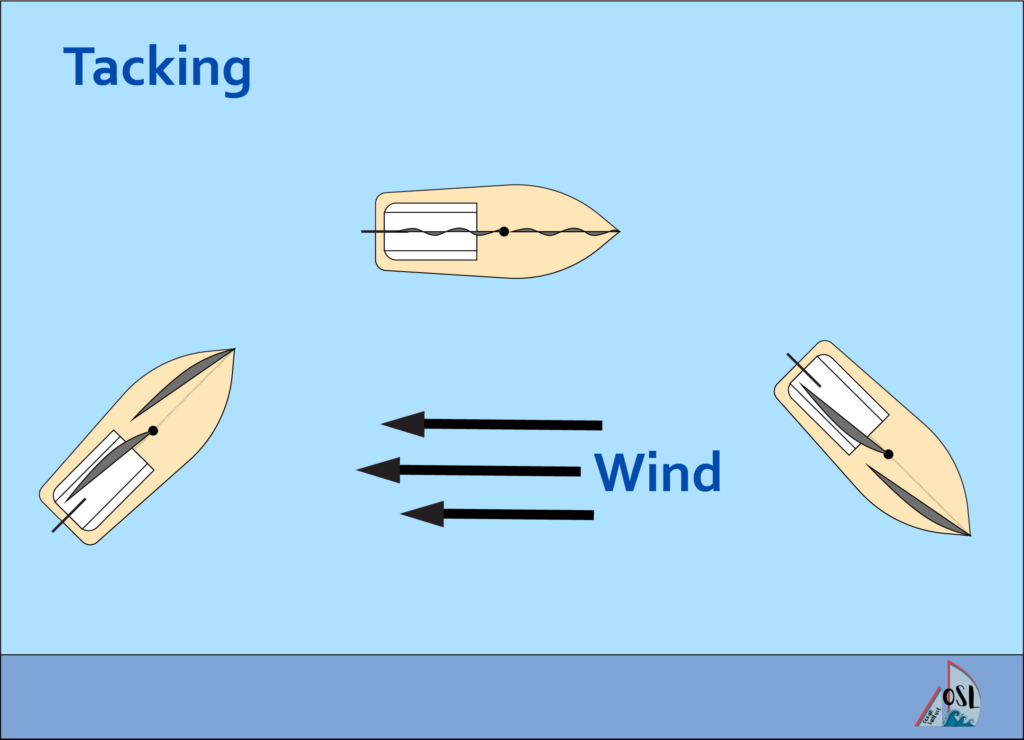What is Tacking? How to Tack and Commands
The world of sailing is vast and complex, with numerous techniques and concepts to grasp. However, one skill that should not be overlooked is tacking. In this article, we will delve into the intricacies of tacking, providing you with a comprehensive guide on how to tack a sailboat like a seasoned sailor.
Understanding Tacking
What is tacking? Tacking is an maneuver used to change the direction of a sailboat by turning the bow (front) of the boat through the wind. This maneuver allows the boat to sail against the wind, also known as sailing upwind or into the wind.
Whether you choose to tack to the right or the left, the goal remains the same. However, tacking encompasses more than just a simple change in direction. It involves understanding the commands, physics, and dynamics of the maneuver. Let us embark on this journey of knowledge together.
Decoding the Sailing Clock
To grasp the concept of tacking, let’s envision a chalkboard with an arrow pointing downward, representing the wind. Draw a circle on the board, starting from the arrow and encompassing the entire circumference. This circle represents the sailing clock. The zone from midnight to approximately 10 and 2 on either side denotes the upwind sailing area, also known as “no sail zone” According to the laws of physics, sailboats cannot sail directly into this zone. To navigate in that direction, we must employ a technique known as tacking.

Visualize sailing from the 2 o’clock position, 45 degrees off the wind, and gradually turning your boat through midnight on the sailing clock to the other side, beyond 10 o’clock. This zigzag pattern enables you to progress towards your desired upwind destination. Understanding this fundamental concept is the first step toward mastering the art of tacking.
The Mechanics of Tacking
Now that we have established the basic principles, let’s delve into the mechanics of tacking a sailboat. Suppose you are sailing with your sails hauled all the way in, known as “close-hauled,” on a starboard tack (right side facing the bow). To execute a tack successfully, you need to turn your boat 90 degrees and begin sailing on the other side of the sailing clock. Let’s assume you are at the 3 o’clock position and want to reach the 9 o’clock position.
Executing a successful tack requires the boat to maintain enough inertia to sail directly into the wind while maintaining forward progress. This means your boat must have sufficient speed at the start of the maneuver. Through practice and experience, you will develop a sense of the speed required for a seamless tack.

Effective Communication: Tacking Commands
Communication plays a vital role in any sailing endeavor. When executing a tack, clear and concise commands are essential to ensure the coordinated efforts of the crew. Let’s explore the key commands involved in a tack.
- “Ready About”: The helm initiates this command, signaling the crew to prepare for the upcoming tack. The pit crew, located in the cockpit, has crucial tasks such as loading up the lazy jib sheet and preparing to release the working jib sheet. It is important to ensure that the foredeck is clear of any obstacles that may hinder the maneuver. Communicate your intentions to those below deck, as any loose items may fall during the tack. Once everyone is ready, they inform the helm by acknowledging “ready.”
- “Hard-A-Lee”: This command signifies the beginning of the tack. While there are variations of this command, the essential aspect is to turn the helm quickly and decisively. The helm, or the person in charge of steering the boat, turns the tiller or wheel to windward, opposite to the direction of the upcoming tack. This action initiates the turning of the boat and sets the stage for a successful maneuver.
- “Ease the Jib Sheet”: As the boat starts to turn through the wind, the crew in the cockpit releases the working jib sheet, allowing the jib to swing across the boat to the new leeward side. This step is crucial to prevent the jib from backwinding and to facilitate a smooth transition to the new tack.
- “Trim the Jib Sheet”: Once the jib has crossed over, the crew in the cockpit quickly grabs the new working jib sheet and pulls it in to trim the jib for the new tack. This step helps the boat regain power and maintain forward momentum on the new tack.
- “Well Tacked”: This command signifies the completion of the tack and acknowledges that the boat is now sailing on the desired tack. At this point, the crew can resume their normal positions and activities, while remaining vigilant for any further course adjustments or maneuvers.
Mastering these commands and their timing is crucial for a successful tack. Practice and clear communication among the crew will help refine the execution of tacking maneuvers.
Every Sailboat Tacks different
Every sailboat has its own unique characteristics when it comes to tacking. Even for experienced sailors, maneuvering a new boat requires a learning curve, as each vessel responds differently to the wind and helm adjustments. It’s essential not to underestimate the importance of practicing tacks on unfamiliar boats. While some boats may tack smoothly and effortlessly, others present challenges. For instance, catamarans, shoal draft keels, and boats with multiple masts can pose difficulties during tacking.

In such cases, a useful technique called “backwinding the jib” can be employed. This involves holding the jib slightly longer on the winch as the boat heads through the wind, allowing the wind to fill the back side of the jib before releasing it onto the new working side. This technique harnesses the wind’s force on the back side of the jib, helping to complete the turn by pushing the bow through the luffing arc. It’s worth experimenting with this method when faced with challenging tacks, while remaining mindful of potential risks to the jib from the spreaders on the mast.
Refining Your Tacking Technique
Tacking is a skill that requires practice, patience, and a deep understanding of your sailboat’s characteristics. Here are some tips to refine your tacking technique:
Remember, mastering the art of tacking takes time and practice. With dedication, experience, and a focus on continuous improvement, you will become proficient in executing smooth and efficient tacks, enhancing your overall sailing skills. Enjoy the process and embrace the challenges as opportunities for growth and learning.
Conclusion
In conclusion, mastering the art of tacking is an essential skill for any sailor. It requires a combination of knowledge, intuition, and experience to effectively navigate through the wind and execute a successful maneuver. By understanding the commands, being aware of the wind’s behavior, and using tools such as a windex or mobile apps, sailors can enhance their ability to “see” the wind and make informed decisions about when to tack.
With practice and determination, sailors can confidently tack their boats, adjusting their course and embracing the challenges that come with sailing. And remember, if all else fails, the trusty motor is there to lend a helping hand. So, set sail, embrace the wind, and let the journey of tacking unfold, for it is a gateway to endless adventures on the open seas.







